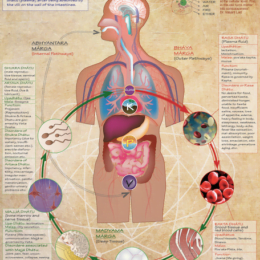
All efforts to counter the pain or derangement of health are cikitsā. It obstructs the progress of a disease condition from further advancing to a more complicated stage and brings back the normal state. The following points, which also form the synonyms of cikitsā, are the key methods of treatment.
- Treatment – The measures taken to preserve health
- Pathya – The diet and regimen for a disease condition and also for a healthy person comes under
- Sādhana – The practices, means, and utilities are used for bringing about or preserving health.
- Ausadhi – Herbs, herbal blends, and various formulations that specifically used for cure.
- Prayascitta – The redemption from unwholesome habits is also cikitsā. The disease is believed to be originating from sin. Here, sin is nothing but the foods and practices that cause disease. Hence, cikitsā is a kind of penance.
- Praśamana – Since diseases are manifested when the doṣas are vitiated, the mitigation of the same
is cikitsā. - Prayascitta – The redemption from unwholesome habits is also cikitsā. The disease is believed to be originating from sin. Here, sin is nothing but the foods and practices that cause disease. Hence, cikitsā is a kind of penance.
- Praśamana – Since diseases are manifested when the doṣas are vitiated, the mitigation of the same is cikitsā.
- Prakṛti Sthāpana – Any alteration from the harmonious prakṛti of life leads to diseases. The ultimate aim of treatment is to eliminate this vikṛti, bring back and establish the natural state.
- Hita – The ways of treatment may not always be to the liking of the person. For example, a condition might demand the intake of a taste which is not liked by the individual at all. But it has to be taken for the betterment. So cikitsā always is expedient that may or may not be appeasing but is always beneficial or suitable.
- Bheṣaja – A disease is a form of fear. So, treatment is that which wins over this fear.
- Upaśaya – At times when the disease is obscure, the trials that we do can also function as cikitsā.
- Upakrama – Treatment requires a specific order. The procedures done in a specific order to fight diseases are also cikitsā.
- Kriyā – Treatment is an action, the term kriyā also denotes treatment in this context.

Classifications of Cikitsā
The goals of Āyurveda are twofold. One is to preserve the health of the healthy, and the next is to cure the disease of the sick. Hence, on a gross scale, cikitsā has two primary classifications:
Ūrjaskara has two categories that are rasāyana and Vājīkaraṇa, which are mostly given to healthy persons for augmenting the tissues and to increase the potency and libido respectively. Apart from this classification, the medicines and therapies done for the above purposes are also called ūrjaskara.
Rogaghna treatment has two variants. Roga praśamana and apunarbhava. The former cures the disease already troubling, and the latter prevents its reappearance. Ūrjaskara and rogaghna cikitsā can be used interchangeably as per the condition of the
patient and demand of the disease.
Depending on the need of materials for cikitsā, there are two broad classifications:
1. Dravya Cikitsā – Treatment using herbs, etc. These materials are mainly 3 types.
a. Bhauma or materials obtained from the earth like gold, salt, etc.
b. Audbhida is those that sprout from the earth. All flora falls under this category.
c. Jāṅgama dravyas are of animal origin like ghee, honey, meat, etc.
2. Adravya Cikitsā – Treatment that doesn’t require physical materials.
Not all therapeutic procedures require herbs for normalizing the vitiated doṣas. They promote the innate capacity of the body to fight imbalances by providing the required atmosphere quintessential for health. Fasting, exercise, sleeping, sun-bathing, consoling, startling – all these are examples of this kind of treatment.
Based on the main principle adopted for the treatment, it can also be classified as follows:
Caturvidha Cikitsā
Four-fold Treatment
1. Śodhana – Cleaning/Purification/Detoxification
• Vamana
• Virecana
• Vasti
• Nasya
• Raktamokṣa
2. Śamana – Palliating/Calming down
• Herbs: Dīpana, Pācana herbs, or balancing herbs
• Fasting
• Exercise
• Exposure to Air
• Exposure to Sun
3. Diet
• Foods: Tastes, qualities
• Drinks: Tastes, qualities
• Guidelines about eating
4. Lifestyle
• Daily and seasonal routine, life cycle routine
• Exercise, yoga, meditation
Other classifications
I
1. Apakarṣaṇa: the means of removing or expelling or excising unwanted constituents or diseased parts from the body. The surgical removal is a kind of external apakarṣaṇa. Internally it is done by pañcakarma.
2. Prakṛtivighāta: All mitigating (śamana) treatments are classified in this category. It is named so as these treatments are opposing the cause of disease.
3. Nidāna tyāga: Aversion expressed towards the etymological or causative factors of diseases. It is primarily preventive.
II
1. Hetu viparīta: Opposing the cause. E.g., wrapping a sunstroke patient with a wet blanket.
2. Vyādhi viparīta: Opposing the disease: E.g., emesis is done in adhoga raktapitta.
3. Tadarthakāri/Ubhaya viparīta: Attuned with the disease or cause but actually alleviating the condition. E.g., giving more alcohol to an intoxicated person.
III
1. Antaḥ parimārjana: Internal application
2. Bahiḥ parimārjana: External application
3. Śastra praṇidhāna: Surgical application
IV – Dvividhopakrama – Two Step Succession
1. Bṛṃhaṇa/ Nourishing
2. Laṅghana/ Depleting
V – Ṣaḍupakrama – The six procedures
1. Laṅghana / Depleting
2. Bṛṃhaṇa / Nourishing
3. Snehana / Oleating
4. Svedana / Sudating
5. Rūkṣaṇa / Drying
6. Stambhana / Blocking
Pāda catustaya
The four pillars of treatment
There are these 4 pivotal factors that hold the key to a successful treatment. They are:
If all these factors are in their best of qualities, then the treatment as a whole attains its goal and the benefit is 100%. Though all these factors are important, the physician is the most relevant. This is because of the fact that even if the other elements are faulty, a wise physician can overcome all its defects and still come up with a good result. But if the physician is not good enough, then cikitsā is compromised, even if the remaining factors are at their best. The physician is the leader and controller.
The ideal features of the pādacatuṣṭaya are:
1. Physician
a. Capable of doing the right thing at the right time
b. Who has acquired the wisdom from the right teacher and scriptures
c. Having vast practical experience
d. One who always maintain hygiene and aseptic conditions
2. Materials
a. That which can be used in various forms
b. That which has multiple qualitie
c. Potential
d. That which is apt for a particular disease, season, etc.
3. Rogī
a. Having monitory support
b. One who obeys the doctor
c. Able to understand and communicate the condition to the physician
d. Having mental strength
Apart from these 4 pillars, other factors could also be considered, like, messenger, longevity, etc.





